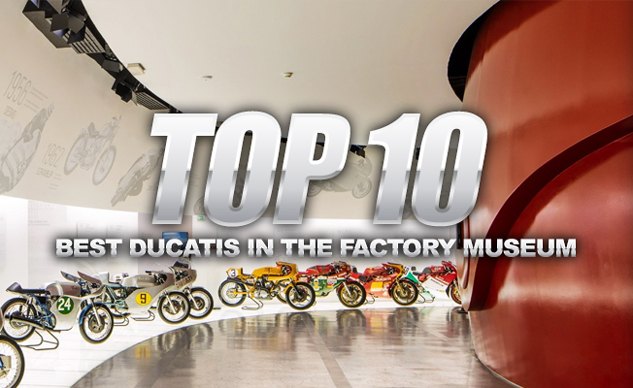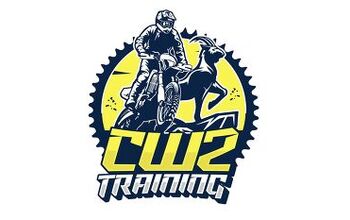Ten Best Ducatis In The Factory Museum
Bellissima in Bologna
Bologna, is the world’s gateway to the picturesque Emilia Romagna region of Italy’s east coast. Quite recently I flew-in a day prior to boarding a bus to Rimini for the international press ride of Ducati’s new 2018 Monster 821.
The highlight of that layover was an informal tour of Ducati’s factory museum… what could be better than to take a quick walk over to the Ducati factory from your local hotel in the Borgo Panigale suburb? It’s a pretty nice place, the walk from the hotel is almost park-like, and the factory itself isn’t too large. Best of all, the Ducati folks are a warm and friendly crew.
The stylish and modern museum is right on the factory grounds and is definitely worth a stop if you’re ever passing through Bologna. I only had my cell phone with me, so apologies for the hand-held and not-so professionally lit photos. Here are my personal favorites from the visit.
10. The first “L-twin” Race Bike: Ducati’s 1971 500GP Bicilindrica
This is Ducati’s very first racing motorcycle to be powered by its now legendary 90-degree L-layout V-Twin. The example shown won the non-championship Yugoslavian Grand Prix in 1971 piloted by Gilberto Parlotti. Another 500 GP Bicilindrica was raced in 1971 by Phil Read, but his only classified result in a World Championship round on it was a 4th place at the ’71 Italian Grand Prix. In the face of an onslaught from MV Agusta and the two-stroke Japanese machines, perhaps the 500 GP Bicilindrica’s greatest contribution was that it became the base for Ducati’s legendary 750 GT streetbike.
9. Dominator: 1981 Ducati 600 TT2
Powered by a 600cc version of the “Pantah” engine and using a trellis-style frame, like the one on the ’79 500 Pantah streetbike, the 1981 600TT2 and its immediate evolutions proceeded to win four TT2 World Championships in a row!
8. 1946 Ducati 48cc Cucciolo
Ducati’s Cucciolo is not actually a complete motorcycle, it’s really just a licensed copy of Siata’s basic pull-rod engine design, coupled with related support and mounting hardware for the conversion of normal bicycles into mopeds. However, it marked the transformation of Ducati from an electro-technical appliance shop into a manufacturer of engines and motorized cycle-related products. Baby steps leading to giant strides.
7. Because, Racebike! 1949 Cucciolo Racing
Less than a year later, Ducati put its Cucciolo motor into a small twin-hoop motorcycle frame and took it to the races. Italian rider Mario Recchia claimed the first ever recorded victory for a Ducati Cucciolo-powered machine on the Feb 15, 1947, at the Vareggio Grand Prix.
6. The First Desmo! 1956 Ducati 125 GP Desmo
Marking its debut appearance with a win at the 1956 Swedish Grand Prix, the Fabio Taglioni-designed 125 GP was the first ever Ducati to use a Desmodromic timing system. It kept on winning too, scoring victories at Belgium and Sweden the following year. At three years old, it dominated the 1959 Ulster Grand Prix piloted by some kid named Mike Hailwood. This is an important motorcycle.
5. MotoGP World Champion! Casey Stoner’s Desmosedici GP07
When the chemistry is right between a bike and its rider, the combination can be unbeatable. At the top of his game, Stoner truly was a force to be reckoned with. The 2007 season saw Stoner and the 800cc Ducati storm to 10 Grand Prix victories plus the rider’s and constructor’s world titles. As a cherry on top, Stoner’s teammate Loris Capirossi rode the other GP07 factory bike to victory in the final race of the season at Motegi.
4. Nothing Will Ever Be The Same: Carl Fogarty’s 916 F94
Foggy won the first of his four WSBK titles on Ducati 916-based machines starting in 1994 aboard this 916 F94. Massimo Tamburini’s gorgeous and iconic design transformed the motorcycle into an authentic work of art. The 916 stole the hearts and minds of street riders, racing fans and racers alike. Meanwhile, Carl Fogarty set to demoralizing his competition wielding the beautiful 916 like a sword as he sliced through the pack. Geeze this is corny, but the 916 does tend to do that to a guy.
3. Ducati Takes Over! Raymond Roche’s 1990 Ducati 851 F90
Ducati launched the first 851 “Desmoquattro” in 1988 and immediately won with Marco Lucchinelli at the Donington Park round of the World Superbike Championship. The 851 was competitive in its first seasons of World Superbike, but it was Raymond Roche who would take the 851 to its greatest heights, winning five races in the 1989 season, before taking this 851 F90 to the World Superbike rider’s title the following year. Desmoquattro-powered Ducatis would go on to score the lion’s share of WSBK championships for more than a quarter of a century following Roche’s 1990 title. The 2019 season will mark the beginning of a new V-4-powered Desmosedici era for Ducati in World Superbike. Can they fill those giant shoes left behind by their own V-Twins?
2. Dovi’s Desmosedici GP17 MotoGP Race Bike
Andrea Dovizioso is our very own underdog folk hero tilting at Honda’s giant windmill. Watching Dovi take the fight to a resurgent Marc Marquez has easily been the highlight of an outstanding 2017 MotoGP season, especially watching him get the better of Marquez in hair-raising last-lap battles. GO DOVI!!!
1. Terblanche & Domenicali’s Masterpiece: The 1993 Supermono
If ever there was a perfect racing motorcycle it was this absolute beauty. The diminutive Supermono isn’t in your face like a Britten V1000, but it’s a work of art nonetheless. The mono its name refers to is its unique single-cylinder engine, which was quite cleverly designed by none other than current Ducati CEO Claudio Domenicali himself. Claudio knows his craft, too: Witness his innovative use of a second reciprocating “conrod” like structure to help offset the inertial pulses of its single piston and let the Supermono rev quite a bit higher than other Singles in its class. It worked… the Supermono won the Italian and Swiss national Singles championships as well as the overall European Supermono championship.










































Comments
Join the conversation
I would definitely put the Ducati Super Mono 500 in the top ten. 75BHP out of a 500 single and predecessor of many Ducati designs... how can you miss it?
Hypermotard